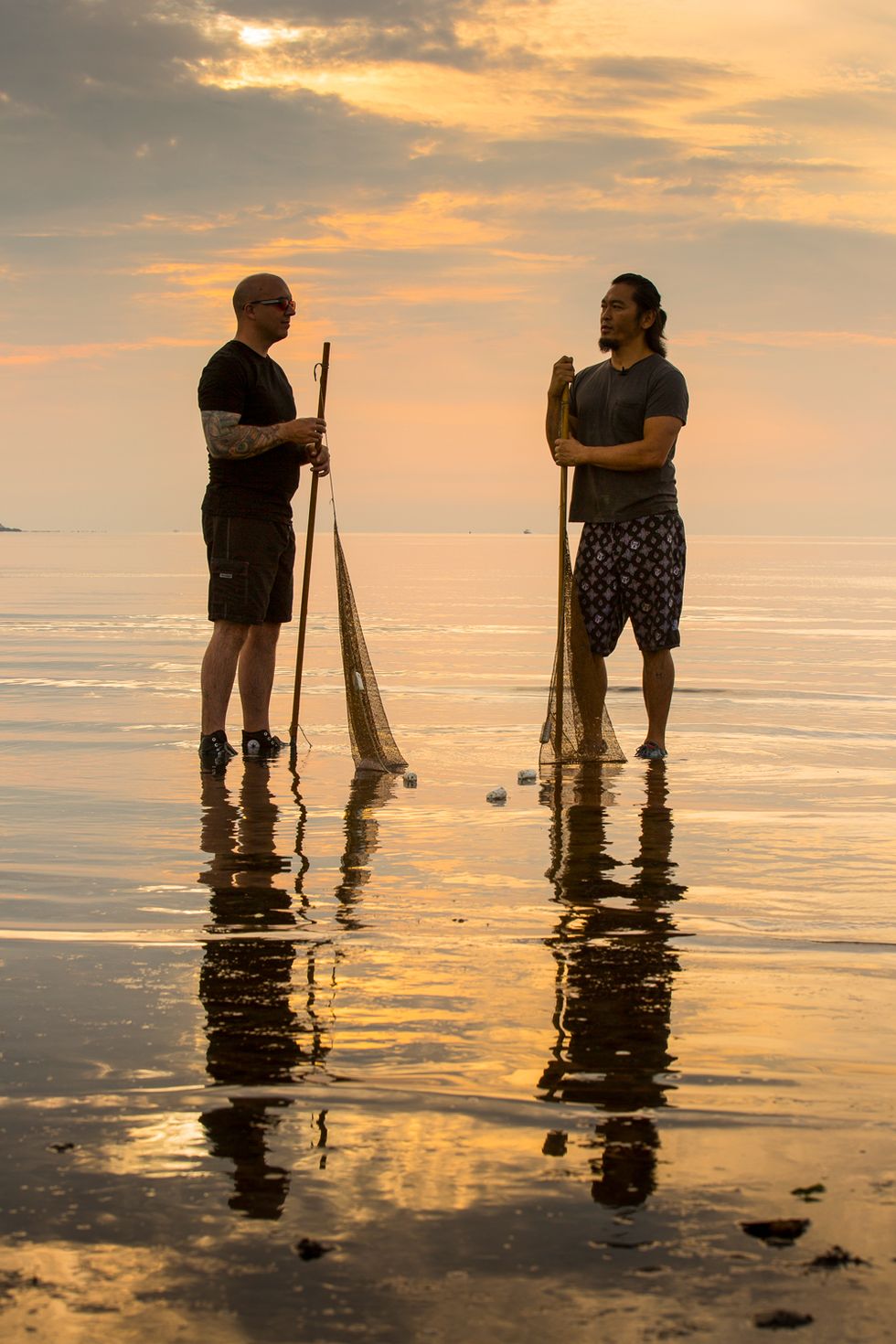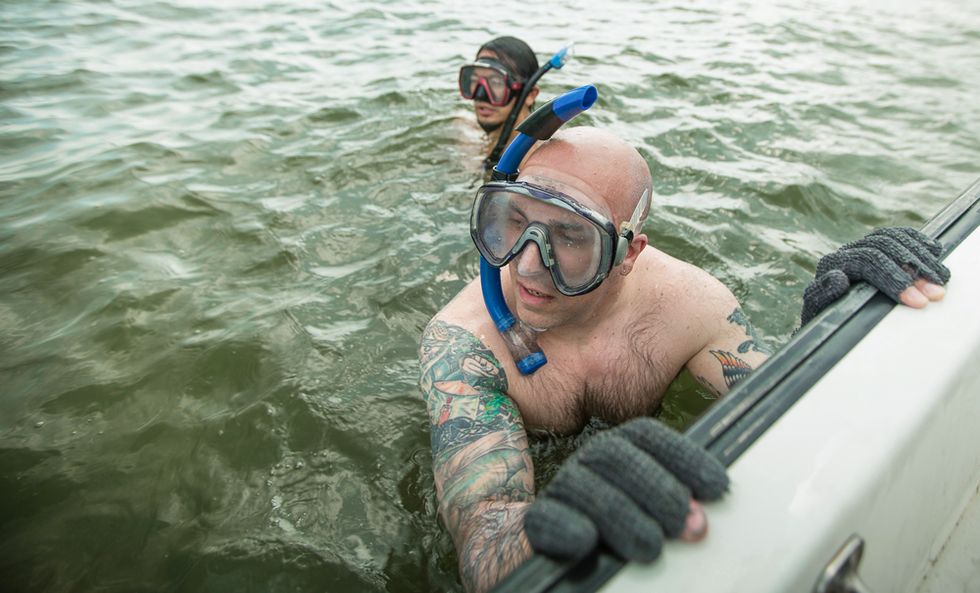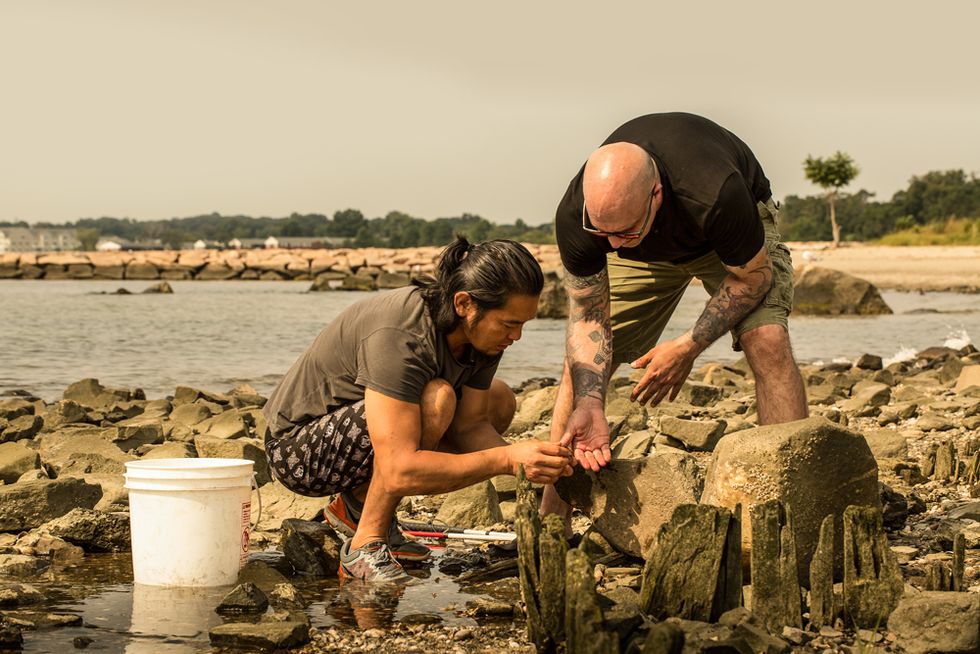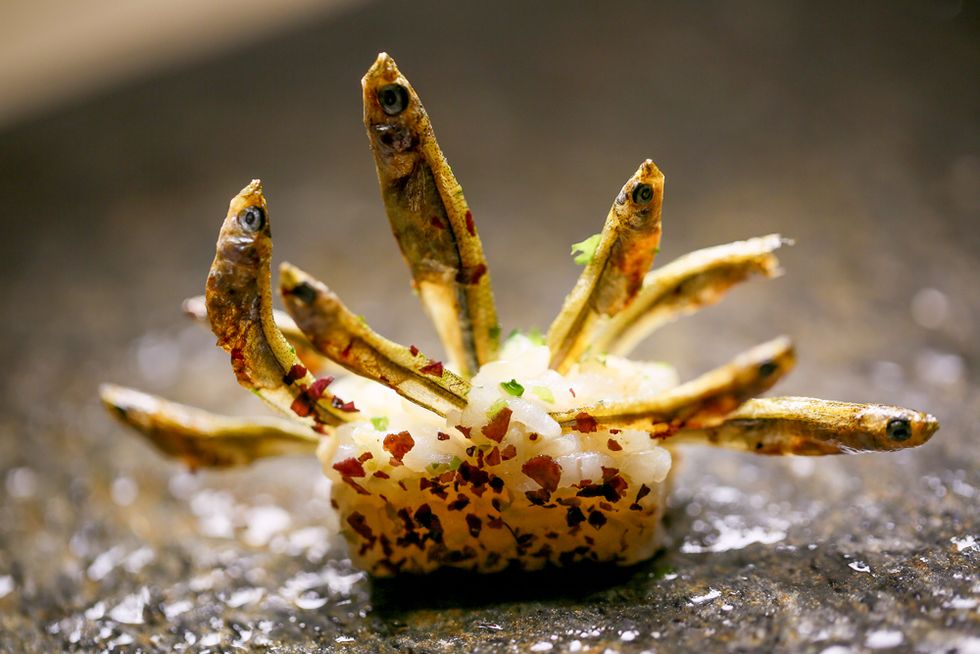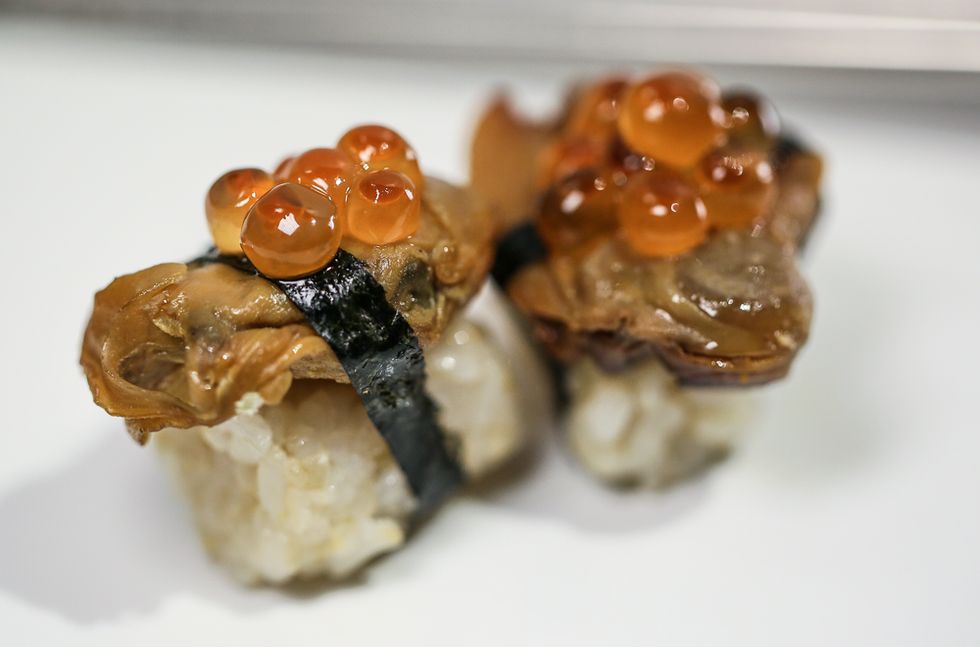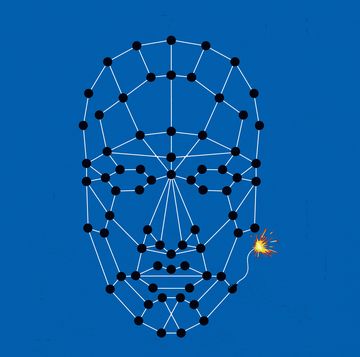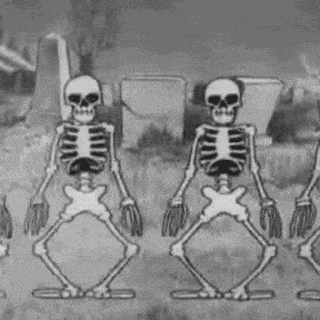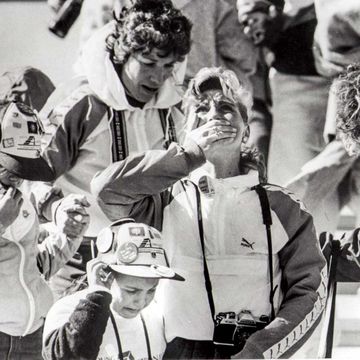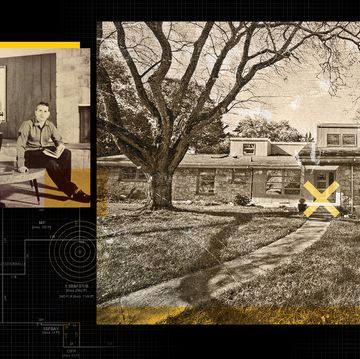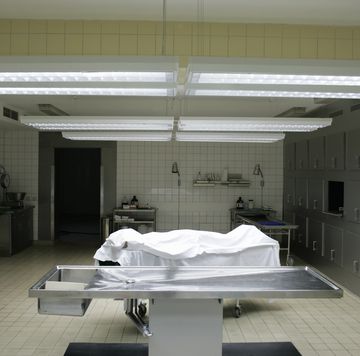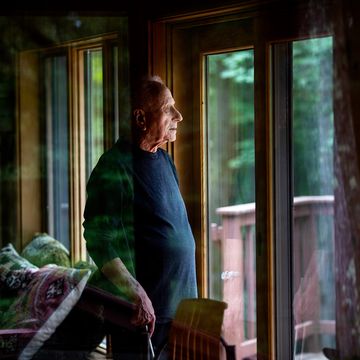A few miles from the mouth of the Branford River, just beyond the Thimble Islands off the coast of Connecticut, rocks jut from the ocean like broken teeth. Some are the size of a kitchen table, others the size of a kitchen, small streams and straits of dark water cutting between them. Perched on one with my friend Bun Lai, a sushi chef, I considered that we could be the only people to have ever surveyed the empty horizon from this spot. My feet were bleeding. I could feel a chunk missing from my right toe and cuts pinstriping my soles. Beside me dripped a bag of rockweed—a dark, tough seaweed we'd harvested by hand as we snorkeled the nooks and shallows. The plan was to add our findings to a foraged feast that Bun would cook for us. That is, if we could get home. We were stranded—our boat high on the rocks after the tide had washed out.
There's something else you should know: I've been blind for more than twenty years. I can't see a thing.
Bun's restaurant, Miya's Sushi, first opened its doors in New Haven in 1982, when his mother, Yoshi, freshly separated from her husband, needed to support herself and her children. At the time, Yoshi saw only two possibilities: She could earn money as a clothing designer or she could open a restaurant serving the cuisine she knew best. Sushi wasn't as popular then as it is now. She feared the business might struggle. If it did? At least she could be certain her children would eat.
A little more than a decade later, Bun would nearly sink his mother's restaurant. It wasn't that he didn't know how to cook—he spent his childhood in the kitchen. The problem was his conscience. As a young man, Bun spent most of his spare time reading adventure novels and romping around in the forest and nearby ocean. His father, a Yale ophthalmologist, pushed him to finish his homework and to learn about science. So Bun compromised, reading science magazines about the outdoors. It wasn't long before he read about ocean contaminants and invasive species, and about how the very fish his mom served were disappearing from the oceans. He knew that there would come a day when he could no longer, in good conscience, turn out another tuna roll.
This story is more about comfort than you might imagine. It's also about restlessness, and safety, and complacency. Tuna rolls are familiar, but they don't do a lot for the environment. And like Steve Jobs and Benjamin Franklin, Bun does not get off on familiarity. He could have just made the damn sushi and brought home a paycheck and gone to bed after House Hunters like anyone else. But Bun was restless. He saw himself not as a chef but as some kind of environmental steward. He could, he figured, use his little restaurant in a forgotten city to try to rehabilitate, in some small way, not just the nearby Atlantic, but all the oceans in the world. Imagine what life would be like without people like that—without people who weren't satisfied with the easy way. No one would ever have found Australia, for one thing.
Bun began to consider how we could turn our destructive power as super predators toward invasive species. Instead of tuna and salmon we'd eat weeds, jellyfish, crisped wax worms—the plants and animals currently demolishing our local ecosystems. After a trip to Louisiana, he even incorporated nutria, a large swamp rodent, into his sashimi repertoire. Early on, customers simply walked out, unable to recognize his inventions as sushi, or even as food. Tables remained empty. Bills mounted.
By the time I met Bun in 2013 at Chicago's Ideas Week, a TED-like festival of provocative talks given by authors and entrepreneurs—and, in Bun's case, an eco-warrior sushi-maker—he was winning culinary awards. He took the stage in an old hoodie and jeans and spoke about foraging for sushi ingredients in the waters and forests near his New Haven restaurant, about his sushi, and about the future of fish.
At the closing party, Bun slid into a booth next to me and tapped my shoulder. He'd heard I was a travel writer. A blind travel writer. Was it true?
It was.
"You remind me of a guy from this novel I read when I was a kid," he said.
The book was Theodore Taylor's The Cay, published in 1969, about a boy and his family fleeing Curaçao during World War II. The protagonist, Phillip, survives the sinking of a torpedoed ship only to be blinded and stranded on an island. But Phillip's new perspective eliminates his inhibitions. He's able to forage by touch and eat things he would have formerly avoided. The story, Bun said, formed his interest in the possibilities of sushi. Imagine what we'd be willing to eat if only we couldn't see it.
I'd also given a talk that week, in which I spoke about being diagnosed with a hereditary retinal disease at the age of eighteen and slowly going blind over the next five years, and about the time I went to Cairo right after the Arab Spring to write a travel story. I had been restless too. It was as if Bun had recognized a kindred soul when he saw me. Like, "Oh, you'd rather ride around in taxis in war zones than sit in a room lamenting your blindness? I almost ran the family business into the ground serving swamp rat to Yale students. Wanna hang out?"
"That's it," Bun said as he pulled on his beer, not his first of the night. "We're going diving."
To be stranded on a rock in the ocean a few years later with Bun is, in hindsight, ironic when you consider the plot of the book that led him to invite me. I wasn't immediately sold on Bun's offer to dive with him, either. Imagine the sensation of swimming down, down, enveloped in darkness, to jam your hands into the mud and grab whatever lurks there, unseen. The thought made me shiver. But blindness, I've learned, is a constant battle against comfort. To be safe is to be bored, and that is in many ways more crippling than blindness itself.
Milford is a short drive from New Haven, its shoreline park locked tight at 4:30 in the morning. Of course Bun knew a way around the gates. Abandoned houses dotted the beach, their blown-out windows staring out to sea like the eyes of Easter Island heads. Hurricane Sandy, Bun explained.
He eased me into the trip. With our buckets and a dragnet, we scuttled to the water's edge to begin our first day of foraging along the rocky shore and tidal pools. In the afternoon we would pick invasive greens like amaranth, garlic mustard, and butterbur from the local woods. Tomorrow we would motor Bun's Boston Whaler to sea to skin-dive for clams and seaweed, the final ingredients Bun needed to cook us a meal.
Knee-deep in low tide, we dragged the net stretched between us like a spoon until we'd gathered enough weight to lift our find to the sand. Dozens of smelt flipped and slapped their bodies, the sound like rain on a sidewalk. One by one I grabbed and pinched them, filling our buckets. The yield could have been purchased from a store for less than twenty-five cents, but Bun has dragged for smelt since he was a child and still loves to do it. A few bluefish, the preferred sport catch of this area, leaped among our smelt. We let them loose. Most people, he said, catch bait to catch another fish. But why not appreciate the bait, which is far more abundant?
A few hours later we spidered our way under the park's wooden boardwalk. My job was to overturn stones so Bun could scoop up the tiny Asian shore crabs that would bolt for cover. Our buckets filled fast with the tiny brown creatures. Bun can still remember a time when the crabs didn't exist. Today they've colonized beaches all the way to Maine. At some point in the late 1980s the crabs were probably accidentally pumped from an international ship's ballast. Not only do they lay hundreds of thousands of eggs each year, Asian shore crabs also eat the larvae of other species to eliminate their competitors. After much trial and error, Bun discovered that the crabs could be panfried in olive oil and seasoned, creating a taste that is an uncanny imitation of a Dorito.
The next morning, the Boston Whaler bobbed in the swells, anchored just inside an inlet. Worried about seasickness, I'd loaded myself with Dramamine before we left the dock. Blindness makes a person sensitive to motion. Once we were over the dive spot, I jumped into the murky water wearing flippers and gloves, only to spin in place like a top as I paddled to keep my head above the waves. An aggressive disorientation bloomed behind my eyes. The ache. The nausea. If I was going to dive for clams like the hero of Bun's boyhood novel, I had to do it quick.
On Bun's count, I took a last breath and shot straight down into the dark, my legs kicking hard and my hands in front feeling for the bottom. Even if I could see, I couldn't have seen through the water. Clamming here is hunting by touch, an equivalent experience for the sighted and the blind alike. Down I continued, my lungs burning, my nerves singing with the primal horror of reaching through the black to touch something unknown.
Mud. Broken shells. I jammed my hands into the silt and clawed, struggling to stay down in place long enough to find, yes, a weight. A shape. A rock. No, a clam the size of a tennis ball. I was almost out of air, already floating up and away when I managed enough of a pinch on its shell to pluck it from the ocean floor like a radish. I had it. I'd found one. Blind people never find anything. How strange to feel the rush of a hunter. The thrill of a predator.
Back on the boat, Bun shucked my first clam. Drink it all down, he insisted. I took the meat into my mouth and slurped. Sand, salt, water, flesh. In a way, it tasted like a glimpse of the world around me. Food can be a way of seeing.
Just beyond us floated a commercial clam dredge. The ship's nose shovels the ocean floor, and its vacuum inhales everything it touches to capture the clams. It spits back the rest. Bun could buy from them. It would be cheaper and easier than coming here with his staff three times a week to raise one clam at a time from the depths. But Bun's right about the way things taste when they have a philosophy and a human touch behind them. They taste better.
The last ingredient for our meal was rockweed, so we motored farther out to sea and anchored the boat beside a patch of jagged rocks. There I snorkeled through seaweed, a sensation like swimming through an endless plume of flowing hair. Within half an hour I had pulled enough tufts to fill my bag, and within that same amount of time the tide had gone out and left our boat, which weighed hundreds of pounds, stranded on a rock. To free ourselves we would have to somehow move the whaler across ten feet of jagged stone, the distance growing by the minute as the tide slid farther and farther from our lonely precipice.
Across the street from the Yale School of Architecture, squeezed between towering apartments, Miya's Sushi is a low-slung node of resistance to the scale and money surrounding it. Profits are not poured into decor. Waiting patrons can peruse some of the restaurant's media coverage on the wall outside the restrooms, or read Bun's own writing for Scientific American. One of many awards hangs over the men's urinal. Egos are kept in their place.
Seated outside on my first night, my fingers traced several crispy knobs served in a basket.
"Japanese knotweed," Bun said, handing me one. "It's one of the ten most destructive invasive plants on the planet."
American travelers returning from Japan first brought knotweed to America. Left alone, it will crowd away other plants and even grow through concrete. Worse, if you dig the roots out from their soil, any crumbled bits will regenerate into a new plant, like a virus. Pickled in soy sauce and chili flakes and tempura fried, however, knotweed is tastier than a kale chip.
Every dish at Miya's includes something that's been growing where it shouldn't, it seems. There are sea robins and mugwort. Venomous lionfish. Even the miso soup is cooked with pumpkin, squash, and "dead man's fingers," a pernicious seaweed Bun tucks as a toasted seasoning into many of his constructions.
The edible species come from far beyond New Haven, as well. Hearing about Miya's, a few struggling Kentucky fisherman contacted Bun for help with the Asian carp that were transported to the U.S. in the 1970s to consume algae in fish-farm ponds but had since escaped into the Mississippi Basin and denuded it of sport and market fish. Today, the carp have proliferated to a degree that they threaten to invade the Great Lakes.
The carp are a perfect example of Bun's philosophy: Though it's a popular meat in Asia and Europe, hardly anyone cooks it here. Who walks into a restaurant and asks for a carp steak? But Bun now receives shipments from the Kentucky fishermen and features variations of carp, raw and grilled, on the menu. A trend, he hopes, will follow. It has in the past. If you've ever eaten a sweet potato roll, you've eaten one of Bun's most successful inventions.
Very few of Bun's dishes challenged me in the ways I'd expected. My blindness didn't seem to be an advantage to enjoying a roll that combines cashew butter, banana, and shrimp, or another of salmon bones and broccoli stems, common kitchen scraps that Bun pressure-cooks into a tender delicacy. They were all tasty enough that my fellow diners and even my wife ate them happily—no blindness needed.
Then came the insects. One roll came topped with a desiccated cricket. One was peppered with dehydrated black soldier flies. I'm told they looked like little raisins. They tasted faintly of peanuts. In other dishes, smoked soldier fly larvae provided a crunchy imitation of bacon bits.
"One pound of beef protein," Bun explained, "can require up to two thousand gallons of water. A pound of cricket protein typically uses about a gallon and a half."
In a world of diminishing freshwater sources, the math is hard to dismiss. Bun raises his own black soldier flies and crickets and worms in small aquarium tanks and feeds them restaurant spoils. The insects are protein and vitamin rich, organic as can be, contaminant free, and dense in healthy fatty acids. Compare that to an industrial supermarket beef steak: Bite for bite, his crickets provide as much nutrition but lack all the health risks of red meat, not to mention the environmental pollution of raising cattle. A person just has to get past, you know, the bug thing.
Even I struggled. Immediately I recognized the cricket's shape with my tongue and reflexively shut my eyes, as if I could help avoid the knowledge of what my mouth was forcing me to see. Did the cricket have an amazing flavor? Not really. Texture? I'd probably have to eat the entire aquarium before I'd get used to it. But the insects were good, in a sense. A very broad, philosophical sort of sense.
So is Bun's strategy working? Perhaps. Other chefs have turned to featuring invasives on their menus. In Washington, Wolfgang Puck's The Source sells invasive snakehead, a carnivorous Asian fresh-water fish that has no known predators in the United States other than adventurous chefs. New York City restaurateur Ryan Chadwick serves invasive lionfish at his restaurant Norman's Cay and has even begun a wholesale lionfish sales business to further target the species. Bun himself has been invited across the country to help others hunt and cook the unwelcome abundance outside their restaurant doors.
For some ecosystems, perhaps it is too late to eat our way out of the problem. But Bun is determined. I've seen his relentless grit firsthand. Marooned on that rock, we put our hands to the boat's hull, dug in our feet, and shoved. The boat gave a couple inches. Sometimes less. Bun hung on the prow while I shouldered the tail sideways in an attempt to walk the boat back to sea. The rocks gashed deeper into our feet with every push. I slipped on blood and seaweed. Inch by inch, though, the boat closed in on the water.
If at any point during our marooning Bun had any regrets about having invited a blind man on a dive trip, he didn't say them aloud. Honestly, I believe he considers occasional crises a natural, even desirable consequence of pursuing rewarding activities. I believe this too: that the best experiences are the ones that try to push you out of them. The ones that, at first look, you might not see.
*This article origionally appeared in the October 2016 issue of Popular Mechanics.

